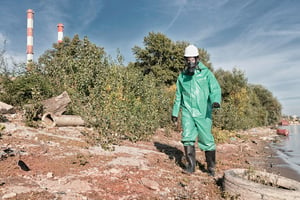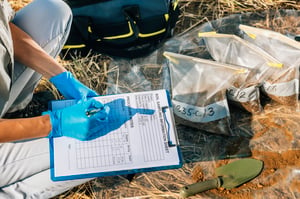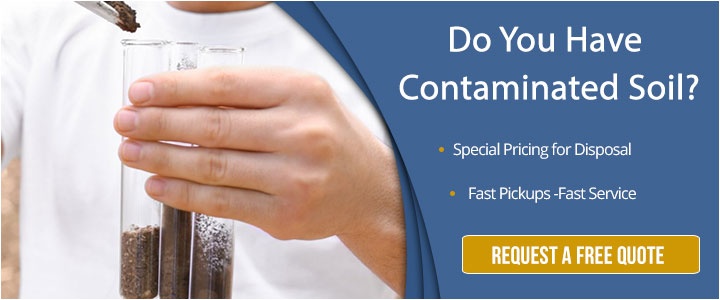Soil pollution is a serious concern because of the impact it has on human health and the environment. Its impact can cause a chain reaction, affecting areas like biodiversity, food security, groundwater and even economic aspects.
What is soil pollution? Soil pollution is the presence of toxic pollutants or contaminants in soil. High enough concentrations of these substances can pose a risk to human health and the ecosystem. Some contaminants naturally occur in soil. Other contaminants are introduced through pollution. In either case, if contaminants exceed levels that should be naturally present, it is considered soil pollution.
How Soil Pollution Happens
Causes of soil pollution can vary since heavy metals and other contaminants can infiltrate the soil in the environment in a number of ways. Soil pollution happens when hazardous substances are buried or spilled into uncontaminated soil.
a number of ways. Soil pollution happens when hazardous substances are buried or spilled into uncontaminated soil.
For example, environmental pollution can occur through human activity, such as when human beings apply agricultural chemicals like the use of pesticides and chemical fertilizers on farmlands or through accidental spills during industrial activity.
A more recent example of soil pollution is the case of Exide Technologies. Soil testing at sites surrounding the southern California battery recycling plant revealed pollution as the root cause of soil degradation. The California Department of Toxic Substances Control estimates that lead, arsenic and cadmium seeped into the ground and contaminated parks, schools and homes in several Los Angeles neighborhoods.
Other sources of contaminated soil include:
- Industrial and manufacturing sites
- Waste disposal sites
- Highway corridors where automobile traffic is found
- Neighborhood and commercial properties where humans use pesticides
- Former farmland
If you’re a project manager, you may have experienced a situation where the presence of toxic chemicals in the past caused soil pollution. Many companies do not know the land underneath them where a project is occurring is contaminated and may not know until the soil is excavated and taken to a nearby landfill for disposal where testing occurs.
Common soil pollutants they may find include lead, arsenic, polyaromatic hydrocarbons (PAHs), copper, zinc and nickel.
It’s also important to note that land pollution or soil erosion can lead to secondary contamination of water supplies, and likewise, water pollution can seep into the nearby soil.
Common Contaminated Soil Categories
Soil contamination often falls into one of the following categories:
- Inorganics
- Semi-Volatile Organics
- Volatile organic compounds
- Fuels
Inorganics
Inorganic compounds typically lack carbon-hydrogen bonds. Examples of inorganics that contaminate soil include:
- Lead
- Chromium
- Arsenic
- Mercury
- Other metals
- Leaded gasoline
- Lead-based paint
Sources for these inorganics typically include facilities where smelting occurs, plating shops and other industrial locations with various manufacturing processes.
Semi-Volatile Organics
Semi-volatile organic pollutants are a subgroup of VOCs that typically have a higher molecular weight and higher boiling point temperatures. Source materials slowly emit semi-volatile organics, which then divide until they settle as dust.
Examples include:
- Polychlorinated biphenyls (PCBs)
- Polynuclear aromatic hydrocarbons (PAHs)
- Dioxins/furans
- Pesticides
Sources for semi-volatile organics include capacitors, transformers, manufactured gas plants, burn pits and various agricultural processes.
Volatile Organic Compounds
Volatile organic compounds, or VOCs, are organic chemical compounds that evaporate easily at room temperature. They include a variety of chemical gases that are emitted from solid objects or liquids. Examples of volatile organic compounds include:
- Industrial solvents like trichloroethylene
- Fuel oxygenates such as methyl tert-butyl ether (MTBE)
- Benzene
- By-products produced by chlorination in water treatment like chloroform
VOCS are often components of products like petroleum fuels, hydraulic fluids, paint thinners and dry cleaning agents.
Fuels
Fuels are often used to produce heat or power. They are materials designed to react with other substances to release energy. Examples include:
- Gasoline
- Diesel
- Jet fuels
- Waste oils
Sources include underground storage tanks, refineries and locations where oil-water separators are used.
Soil Contamination Clean-Up Options
Contaminated areas require soil remediation and treatment before a site can be considered decontaminated. There are several approaches to this clean-up procedure. The most common options include:
are several approaches to this clean-up procedure. The most common options include:
- Containment
- Bioremediation
- Chemical oxidation
- Soil washing
- Thermal treatment
When a site undergoes containment, heavy-duty liners are typically placed under and around any contaminated solid to prevent the migration of contaminants into soil or groundwater. These liners must be periodically checked for damage, and additional sampling may be required. A landfill cap then serves as a barrier layer that prevents adverse effects on nearby areas.
Bioremediation uses organic materials to initiate biological processes in the soil that eventually will remove contaminants. Microorganisms such as bacteria and fungi are used in this process because they use the contaminant as a food source. Bioremediation is often used when mitigating pollutants like halogenated organic solvents and compounds, hydrocarbons, nitrogen compounds, some metals and non-chlorinated pesticides and herbicides.
During the chemical oxidation process, a compound is injected into the area of soil contamination. The primary responsibility of this reactive chemical oxidant is to destroy the contaminants. This solution is sought after when soil contamination occurs at deep levels below a structure.
Soil washing physically separates soil from its contaminants. During the washing approach, a solution comprised of cleaning fluid and water passes through a polluted soil sample. Contaminants are more likely to bind to fine-grained soil and silt, and soil washing effectively removes these fine-grained pieces from the larger soil sample.
The thermal treatment method moves contaminants in soil using heat. During this heating process, some contaminants are destroyed. Others move through the soil toward another place, such as wells, where crews collect them and pipe them to the ground surface. Also known as “in situ,” the heat is applied underground directly to the original area of contamination.
How Disposal Services Can Help
Whether an on-site accident has occurred that leads to soil pollution or contaminated soil is a complete surprise, hazardous waste disposal companies can help.
Keep in mind that even if you have excavated soil and have transported it to a disposal site, if testing done at the site reveals there are high enough concentrations of industrial pollutants present, you are still responsible for arranging for that soil to be transported from the landfill to the appropriate facility that WILL take the soil.
As a project manager or business owner, searching for a landfill that will accept your industrial waste can take a lot of time. Hazardous waste disposal services can help by removing the contaminated soil and transporting it to the appropriate facilities, even if those landfills are across state lines.
Experienced disposal companies have developed connections with hazardous waste disposal sites throughout California and across the United States.
When searching for a disposal company, make sure it offers hazardous waste determination services through sampling and profiling to determine soil quality. A licensed contaminated waste removal company will test and classify the soil early in the process so you aren’t surprised by a positive sample at the landfill. If the soil isn’t hazardous, you shouldn’t have to pay the added costs that come with specialized hazardous waste removal.
The best soil contamination services will also:
- Help you develop a transportation plan
- Complete regular paperwork
- Provide proof that your contaminated soil has been properly disposed of
- Register with the DTSC
- Offer a hazardous waste walk-through program that can help you identify potentially contaminated soil and help you ensure your waste management plans are in top shape.
One final note: Always avoid working with hazardous waste brokers who act as unqualified middlemen. Hazardous waste brokers are often unqualified and drive up costs, so you end up paying more for the same services you would have received if you had contacted a hazardous waste transporter directly. Even worse, you will likely not know whether the company you are working with is even qualified to handle your type of soil pollution.


Comment